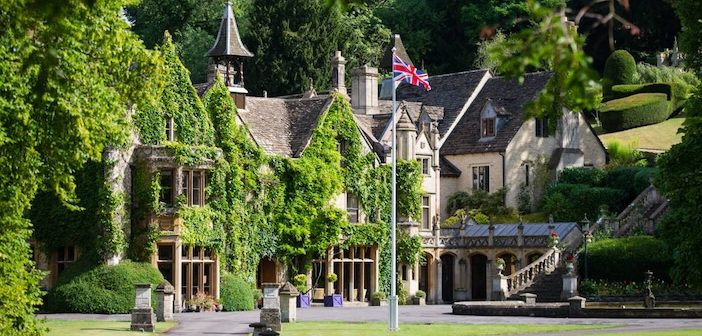In the postcard village of Castle Combe, Larry discovers a country hotel so enchanting it blurs the line between film set and fairytale, with a Michelin-starred flourish for good measure…
It’s hard to overstate how beautiful Castle Combe is. Location managers for film companies would agree. I remarked to Mrs L, as I concluded my walk back into the village, past the Bybrook stream and over the stone bridge, that it’s like walking into a film set, such that I was tempted to peer behind the weathered stone facades to see if they were simply propped up by wooden scaffolding. Needless to say, as I returned to our cottage and put the kettle on, I looked it up and, indeed, among the likes of Warhorse, it was the setting for one of her favourites, Stardust. Well, that’s double brownie points for impressing her on her birthday, then.
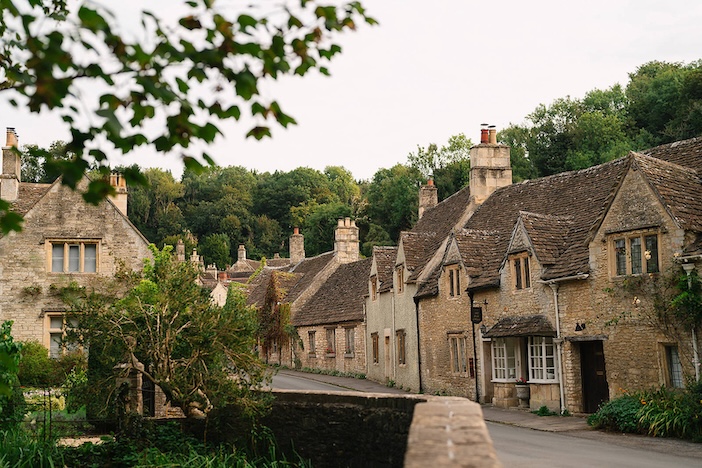
What’s equally special is the feeling you get when you stay here, too. Pulling into the village and passing the gaggle of tourists to drive through the gates of The Manor House, there’s a hint of celebrity to the occasion. “Yes, I’m staying here…” my glance said as we passed the gawking hoi polloi.
The drive sweeps around the lawn, the ivy-clad manor coming into view across the stream. It’s so quintessentially ‘country house’ that I’m slightly self-conscious that my dirty Audi – ahem, I must remember the open-top Morgan next time – was about to blight its image as I pulled up to the front, and I half expect to be holding the door open for Miss Marple as I enter.
“You’ll be in one of our cottages,” I’m told as we check in. I’m suddenly crestfallen. You mean we’re not in here? This wood panelling, the old beams, the four poster, the rolltop bath in front of the lead lined windows? What do we get, then?

More fool I in my ingratitude. When you come to The Manor House, ask for a cottage. From the hotel, each of the cottages up the lane leading to the village belong to the property. Ours, Golden Leigh, is a stand-alone stone bungalow, tucked behind the church. We were, to all intents and purposes, stepping into our own scene from Stardust.
Entering from the nook of the storm porch, inside is a perfectly proportioned suite; a semi-height partition wall retaining the charm of the beamed ceiling, the muted tones of the soft furnishings make it immediately inviting, and details such as the stained glass windows, the companion ‘lion’ plush to indicate room service, and welcome amenities all designed, quite literally, to make you feel at home.
Which is precisely what Mrs L did, rather too readily. Before I was back from the car with the bags, she was already in the bath, Aquavision TV on, glass of Ridgeview in hand. Thus, as she enjoyed the bubbles in the bath – and her glass – I ventured out to familiarise myself.
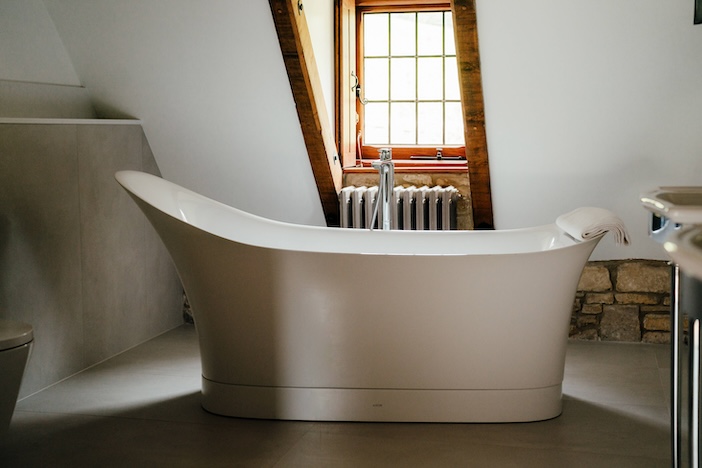
We’re on the fringes of Cotswold country, which, apart from those picture frame villages and stone cottages, has some fine countryside, and the Manor House takes advantage of this, encouraging guests to walk, with an illustrated guidebook in the room. With the sun setting, I curb my ambition with a short loop through Parsonage Wood – beautiful in the autumnal tones – but there are mightier ambles, to Nettleton Mill and Long Dean – and return to the homestead for a cup of tea.
While we might have happily stayed cocooned in Golden Leigh, there was an entire Manor House to consider. Inside, it’s a veritable estate of nooks, reading rooms, lounges and wood-panelled passages, bedecked with landscape oils, portraits and the occasional suit of armour. Many beautiful rooms, each with their own character that you’d think you were in a different property each time; the tea lounge with gilded stucco; the billiard room with its massive inglenook; and then there are all the simple quirks of age; the uneven floorboards, the weathered stone, the Gibbons-esque carved doorframes.
 It set the scene for a perfect invernal aperitif in the bar. As we sat, an American couple adjacent to us recommended the Apple Pie. Not one, I noticed, on the menu; it was a custom concoction created for them. I asked what brought them here. A week scouting venues for a Cotswolds wedding, and this was one of their stops. “And have you decided?” I asked. They had. The Manor House, naturally.
It set the scene for a perfect invernal aperitif in the bar. As we sat, an American couple adjacent to us recommended the Apple Pie. Not one, I noticed, on the menu; it was a custom concoction created for them. I asked what brought them here. A week scouting venues for a Cotswolds wedding, and this was one of their stops. “And have you decided?” I asked. They had. The Manor House, naturally.
We migrated through to the restaurant, Bybrook, for dinner, and a very different feel to the rest of the house. It suddenly becomes more expansive, almost medieval-gone-futuristic, as contemporary design blends with stone walls and lintels. If I thought the treat was, simply, staying at the Manor House, what goes on at Bybrook puts that notion to mere window dressing.
Having previously helmed the kitchen at Lucknam Park, when Executive Chef Robert Potter joined The Manor House he gained his Michelin credentials within a year, and from the precision and flavour he’s conjured up in his tasting menu, it’s easy to see why this is a destination beyond just the hotel.
We’re given an arsenal of cutlery in preparation for ten courses that would prompt Mrs L to practically frame the menu when we left. Two courses in and I could have happily retired to bed; trout with wasabi and roe is a one-bite wonder, and I’ve never had grouse in a tortellini in a consommé with truffle, but now tortellini will never be the same. The bread wasn’t even bread, but a brioche croissant, a ‘broissant’, if you will.
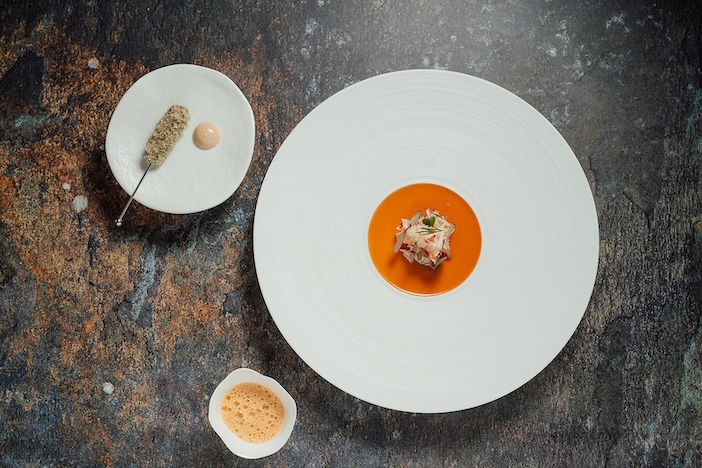
Each course, Mrs L and I keep declaring it our favourite, such that by the time the crab came – with lemongrass, kohlrabi and lime – I literally licked the bowl. But then there was seabass in a champagne sauce with oscietra. And perhaps the most intriguing dish, simply called ‘Barkham Blue-Apple’. A sliver of the cheese is served with a mini tarte tatin, designed to be eaten together. If you’ve ever had Stilton and Christmas pudding together – yes, that is a thing – this betters it. Forget salted caramel, blue cheese with dessert will soon be all the rage.
And yet we still had dessert to come. A pre-dessert, simply ‘mango, coconut, passion fruit, lime’ on the menu is deceptively presented as a gilded quinelle of sorbet on a white coconut foam; but put the spoon in and you reveal the depth of the bowl, with a passion fruit and mango posset. While the actual dessert was nothing short of genius; a white chocolate mousse on toffee-like caramelised fig, topped with blackberry ‘salad’ and a fig sorbet.
So often, a restaurant in the country hotel, unless it has a name behind it, can be an afterthought, but Bybrook is a tour de force. Indeed, it’s hard to decide what is the bigger draw, the hotel or the restaurant. To the extent that we’re delighted to be back there the next morning, crisp sunlight casting its hue through the stone lintels over our table. And as we sat there, basking in that morning glow with coffee in hand and the faint echo of church bells drifting across the lawn, it struck me that The Manor House achieves something rather rare.
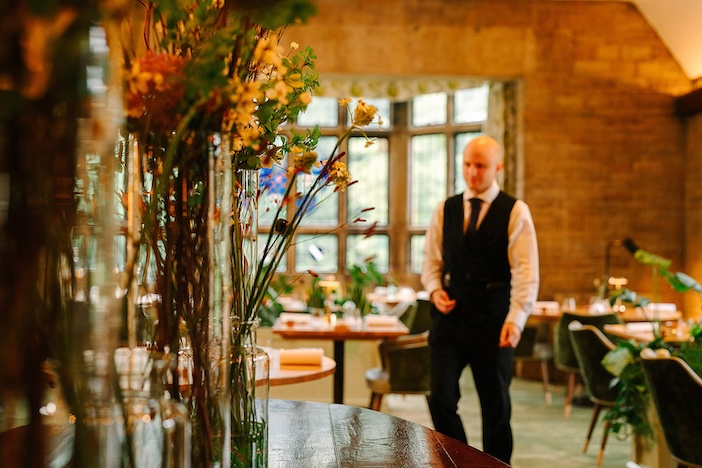
It isn’t merely a place to rest one’s head, nor simply a restaurant with a Michelin star attached like a shiny brooch; it’s a complete little world, self-contained and quietly enchanted, where everything – the cottages, the crooked beams, the woodland paths, the murmuring Bybrook – conspires to slow your step and soften the edges of life. The American couple had chosen it for their wedding for good reason; it is, quite simply, a place that casts a spell.
Driving out through the gates, past the village with its film-set charm, I glanced at Mrs L and saw the unmistakable expression of someone already plotting a return. And who could blame her? In a corner of England so pretty it barely seems real, The Manor House does the impossible: it makes reality better than the fantasy.
The Manor House is part of the Exclusive Collection of hotels. For more information, including details of Christmas stays, afternoon tea and festive dining, please visit www.exclusive.co.uk. NB Side effects may include lingering daydreams, excessive contentment and cravings for ‘broissants’.

